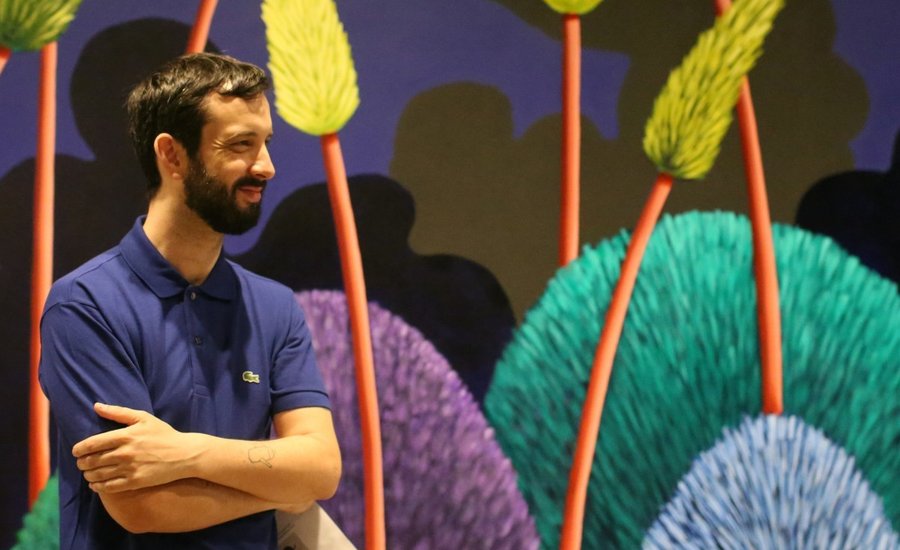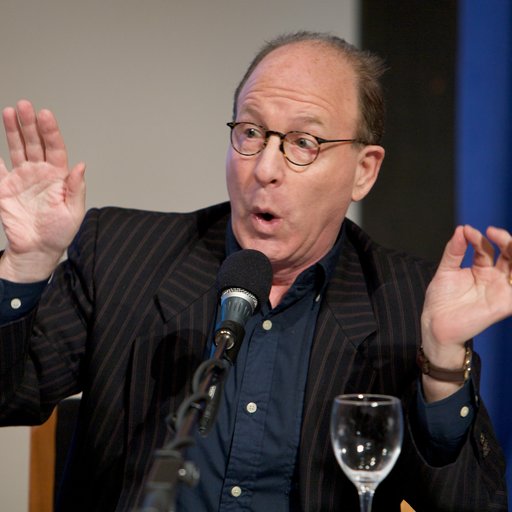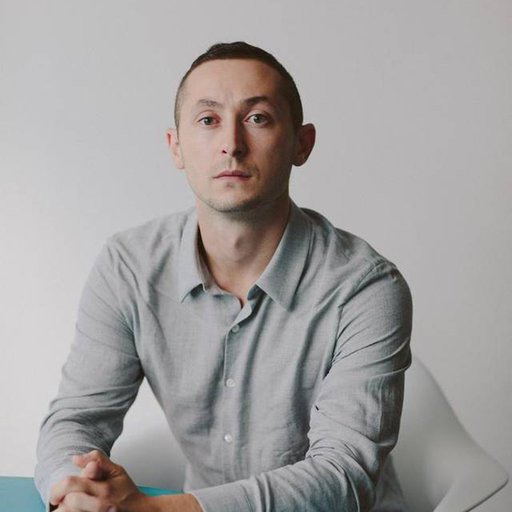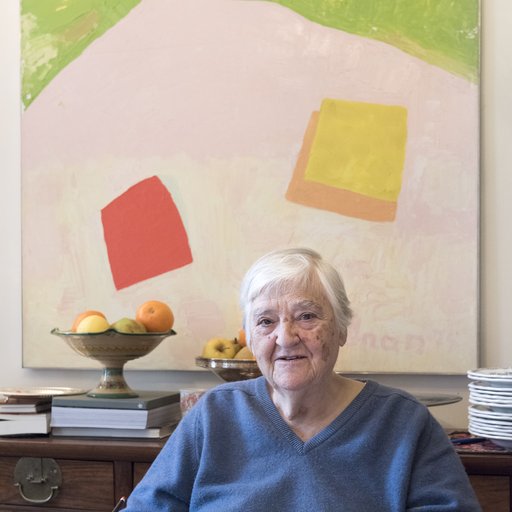Nicolas Party paints with a style that can only come from an artist who has spent equal time behind computer keyboards and in museums of modern art. After working for 10 years as a 3D animator, the Swiss approaches his art with the understanding that separating “real” images from computer-generated ones is becoming increasingly difficult, and that our perception of the world around is powerfully shaped by the images that illustrate it. As a result, the smooth, bulbous volumes he paints—mundane objects like trees, vessels, fruit, and generic people—look not like traditional representations of life but instead hollow shells in a vacuum, not unlike 3D-rendered objects in virtual space. Oddly, despite their alien veneer, they also exude a kind of sincerity and joy that is hard to find among Party’s generation of painters.
The Post-Internet artist's unique and celebratory style has not gone unnoticed. Party was recently included in Phaidon’s Vitamin P3 definitive compendium of the best contemporary painters in 2016; this year alone, the artist has had solo shows at the Modern Institute in Glasgow, the Dallas Museum of Art, the Centre d’art Neuchâtel in Switzerland, and the Glasgow Print Studio. Next month he’ll present a solo exhibition at the Hammer Museum in Los Angeles.
Could it be that Party and other artists like him are the bridge for traditional painting to evolve into our digital future? For the latest in our series of interviews around Vitamin P3, Artspace’s Loney Abrams spoke to the spirited painter about the gallery-as-theater, the relevance of Egyptian sarcophaguses, and the virtues of banality.
Let’s talk about your process. Do you paint from life?
Most of the time I paint from my reality, which is made of the images that exist in the world already. We probably see many more things represented as images than as the objects themselves in reality, since we’re always looking at pictures and images nowadays. So my inspiration comes mainly from images of what I want to represent. For instance, my portraits are inspired by other portraits and the history of representing the face. It’s the same for trees. Looking at nature is not part of my creative process—instead I’m inspired by drawings of trees, which could be illustration, art, photography… anything, actually. Even kids! [Laughs.]
Which artists are you looking at?
Well, when I look at painting, I’m a little bit polluted by my practice. For example, I’m doing cats at the moment so I will look very closely at everyone else doing cats. I look at the technique, ask myself, "Why are they doing a cat?" or "Why are they using that symbol, that character?" But that’s the same for every artist. That said, I moved to Belgium and I discovered a couple of Symbolist artists from the early 20th century that I’ve been looking at a lot during the past two years—Léon Spilliaert and William Degouve de Nuncques. They are both very symbolic painters, not very well known, and Degouve de Nuncques especially was a very good pastelist. They both use trees and very simple figurative gestures to evoke something very atmospheric.
I also discovered a Swiss artist called Hans Emmenegger who is not well known, but he’s a fantastic figurative painter. He’s a little bit between [Félix] Vallotton and maybe Alex Katz, and funny enough, there was a show once of Alex Katz and Vallotton [at Musée cantonal des Beaux-Arts in 2013]. I’ve been looking at how an artist can use very simple figurative elements, and push to really cut the meat off, and try to not have a style that is too visible. Cézanne, for example, is really stylish and also cuts a lot of meat off the subject to try to get to the essence. These painters I mention are slightly different—they’re closer to my practice so I try to learn through them. I can go quicker in my research by just looking at their work so I don’t do the same thing they did, because they already did it.
From the contemporary arts, I really appreciate and respect the work of Pierre Huyghe, mainly because of his use of layering. He did a beautiful video and installation at the Met last year. He has an amazing, powerful way of layering different types of meanings and objects in the same artwork in a way that is super rich, and he’s really trying to get you lost in it. He packages stories in a poetic way and has a subtle way of approaching a little object, like a treasure. So I saw a sculpture of his when I was doing a show in the DMA in Dallas and was very inspired by it. In my work the layering is obviously way less complex, but that’s one of my goals: I want to have my layering be more complex than what it is now.
It looks to me like the figures in your portraits are hollow, as if their surface is a hard outer shell with nothing underneath. I get the sense that you see them as still-life objects just like you would see a vase or an apple. Is that fair?
Yeah, I was doing a lot of 3D animation 1- years ago. I was doing very simple abstract forms with simple geometric shapes. I think this kind of fake, ghostly look you’re talking about is what you see when you look at any 3D image, which creates a reality out of actually nothing. We’re so used to seeing computer-generated images now that it has a big impact on how we see all images. I think this describes the look my figures have. I see them almost as like a thin layer of something and I don’t know what is behind them. Like all the imagery in magazines—we don’t even know if it’s a real perfume bottle or not. I think that everybody is consciously reinventing or recreating their perception of what is real. Before, when you saw a photograph of a person, it meant that someone was there and someone else took a picture. Now, of course, there is no way to know if that person ever existed.
Also, I was very influenced at some point by those amazing late Egyptian sarcophaguses, when the Greek were actually already in Egypt and they made portraits on the outside of the coffin. You’ve probably seen them in museums—they’re absolutely beautiful. They always painted a portrait of the dead on the coffin and they look really, really strange. The face is just a very thin layer on the surface, but what is behind it is still a big mystery. When you’re a painter, and you paint portraits especially, you are obviously painting the outside of something—only the few millimeters that you can reach with your eyes. You can’t see inside, obviously. And your eyes only see the outside of things.
Are your figures are gendered?
Well, yes and no. In my head I’m painting a male because I’m male. And when I think about gender, and what a woman or a man is, I’m only asking from the point of view of a man. Also, the history of portraiture has mainly involved male artists depicting young women. In 2016, it’s impossible for me to just paint pretty women. It wouldn’t make sense. There’s a lot of pretty girls in the street, and you can say, "I paint beautiful things so why not beautiful girls? I mean, that’s a good subject, right?" And, actually, of course, it’s not, because it’s not asking the right questions about what is beautiful and what is a beautiful person or a beautiful face.
I thought to also give the figures in my portraits makeup. They all come from classic Greek and even pre-Greek portraiture where, in line with the Greek aesthetic, the face of a woman or a man is the same. They tried to reach beauty as perfection in statues and it doesn’t exist in reality. Nobody looked like sculptures! But they’re trying to have this perfect face, with these perfect features, and the features were the same for men and women. Either the men are very feminine or the women are very masculine, but they’re very close.
Your work often has an incredibly light, shallow-seeming surface and at the same time is very visually arresting. What materials do you paint with?
I worked with spray paint for 10 years. Spray paint is very specific in that it’s very, very limited. You need to find basic ways to mimic volume and depth using very limited options. So I still have those skills, and that’s why I love working with chalk pastel because chalk pastel is also very technically limited. All my painting in the past four years has been with chalk pastel.
I’m going to go back to oil painting next year—that’s my big plan. I think I’m ready. But oil painting is much more difficult and complex. You don’t see that many people painting where they really grab the specificity of the material in the right way. And I think what’s also part of the mission of the artist is to understand the medium that they work with. Like Matisse with his cutouts—his cut things are the essence of cutting things. Nobody can beat that. And with oil painting, the greatest painters are still the masters of the craft, I think.
Your subject matter is usually pretty banal—trees, fruit, pots, portraits, and you just mentioned that you’ve started to focus on cats as well. Why do you paint the things that you do?
They are indeed banal, but they’re nevertheless very interesting! [Laughs.] They are banal because they’ve been painted a lot. Nothing is banal in itself. For example, the Mona Lisa is a banal painting because we see it everywhere, but that doesn’t mean it’s not an interesting piece of art. The portrait is probably the most produced image on earth. People take pictures of themselves or other people’s faces because at the end of the day, thank god, we still have an interest in other people. The face is a fascinating thing to look at.
But I think that in choosing banal subject matter, I was trying to avoid having to come up with an idea for something new. I didn’t want to think, "Oh, I’m going to paint this, and nobody painted that before, so that will make me original." I guess when you’re a teenager you think, "I need to invent something." Especially in school when you learn about Modern art and you hear, “This was the first painting of prostitute and that’s why it’s so amazing!” Or, “He painted a train and nobody had painted a train before!” So I thought, "I’ll paint an iPad and a hard drive and it’s going to be great."
But I went the opposite direction and painted things that have become banal because they’ve been painted so many times: a couple of apples, flowers, trees, portrait, cats. Cats are such overused subjects at the moment. I felt cats were a nice, interesting challenge. And if cats are so important on the internet and in the lives of people, that means they have some kind of importance. I avoided trying to find a new subject. But abstract painters do something quite similar. They just paint abstraction. It’s an easy way to paint, too. Maybe too easy. [Both laugh.]
In your work, I’ll look at a painting of four trees and they feel like the size of carrots, while a vase looks the size of a skyscraper. Somehow you’re able to play around with scale in this way that's hard to articulate. Is this something that you’re doing consciously?
That’s a really good point. Nobody has told me that before—it’s good. It totally makes sense. Again, I think it’s because they’re not from a real world. In the world of images, everything is possible, almost like the Alice in Wonderland. Also, in Photoshop you can shrink and hide things very easily. Everybody and everything can change. I think maybe that’s why I love art so much—the greatest thing that humans have is the capacity to see things that don’t exist. I don’t know what animals do, but we can guess they don’t do that much. They seem to be really focused on their very primal needs. I don’t know, who knows, maybe in 100 years we’ll discover that we’re the most stupid species. I started to listen, a lot, to This American Life, and I think about how now there are so many stories already but the human brain keeps wanting to look further for no reason. I think art is the same quest—it tries to create those objects that don’t have any purpose, but are still necessary.
Your gallery exhibitions are unique in that you make paintings on the walls, and then hang painted canvases on top of them. Sometimes the wall paintings are very patterned and decorative, which reminds me of how paintings in the past were normally seen—over wallpaper.
Well, that’s definitely one of the references. The white wall was basically invented with contemporary art. But before that, especially in the 19th century, white walls didn’t exist much, especially not white cubes. There were ornaments everywhere, a lot of colors, and some things hung on fabrics. So it’s actually quite a recent idea that the artwork is not part of the environment.
Why did I start painting on the gallery walls? One of the explanations, which is not very amazing, is that I’m from Lausanne [in Switzerland] where there’s an artist called John Armleder. He is a fantastic Swiss artist, probably in his 70s. He was extremely well known where I grew up—a kind of a god. And he integrated his artwork with decoration and design and questioned the boundaries in between, like most '70s or '80s artists I guess. But, anyway, a lot of people where I’m from were doing murals and hanging things on top. And still today almost all of my friends from that town do that. But when I moved to Glasgow, they said, "Oh, it’s great, you’re hanging things on the mural!" and I was like, "Well, where I’m from everybody does that." [Both laugh.] That’s my explanation, anyway.
But my thing was to create a space like a theatrical set. I’m working with subjects that are not from reality, so I think I have a tendency to love this idea of the gallery wall as a theater or a set. So the show, for me, is also a little theater. I try to play with the space itself—what it means, what it’s like.
Recently I’ve been doing fake walls. It’s extremely common for galleries to move into industrial buildings and make fake walls, but they don’t go to the top because they want to save money, or just show the industrial look. So the result is a 3D, fake Western box—a pristine white cube—plopped in an industrial building. It becomes visible when you look up but if you look down, you only see the white walls. In terms of architecture, it’s extremely bad and ugly. It’s kind of charming, I guess, and I don’t have anything against fake walls, but they are a total artifice. So I’ve been using fake marble, for example, to play a lot with this idea of something very fancy but totally fake. Or I build other fake walls that take up way too much space.
When I was looking at your work online, I saw a painting hung on a wall that had a mural painted on it and I thought that it was all one painting—a single painting with a smaller painting within it. It seems like your really need to be inside the gallery to fully understand what’s going on in your work.
Oh, that’s interesting. Nowadays, artists are totally aware that people are seeing their work through screens. It’s consciously or unconsciously affecting what they’re doing; they work in two different dimensions. So, some people play with it, some people just try to forget, and some people hate the screen thing… but there’s really nothing to hate. That’s just how it is now. I’m totally conscious of that, and I make decisions that I know will work very well in pictures because I also want the show to look good online.
In fact, my portraits couldn’t exist before the computer. I grew up with computers, I’ve created tons of things on computers, and all those images are in my mind when I paint. So it would be very naïve to say to myself, "I created a painting that is independent from the computer’s role." My paintings are flat with really big colors. When I was doing 3D design work, I would put flat backgrounds behind the volume so that it would show up better.
I’ve been thinking a lot about that and have been reading about perspective in Renaissance painting—it totally changed our way of seeing everything. And the invention of perspective was also a way to describe the world and think about the world. And I can’t help but think that our ability to design in 3D is really affecting our view. The digital age, with all these 3D and digital images, is drastically changing our way of seeing things, the same way that the invention of photography changed with way we saw. And for an artist, that’s very interesting. I do think that a lot of my visual solutions are strongly connected with all those ideas. So if you saw the painting, as you described, incorrectly, that’s really cool—that means there are two levels of seeing the work. Even better.



























